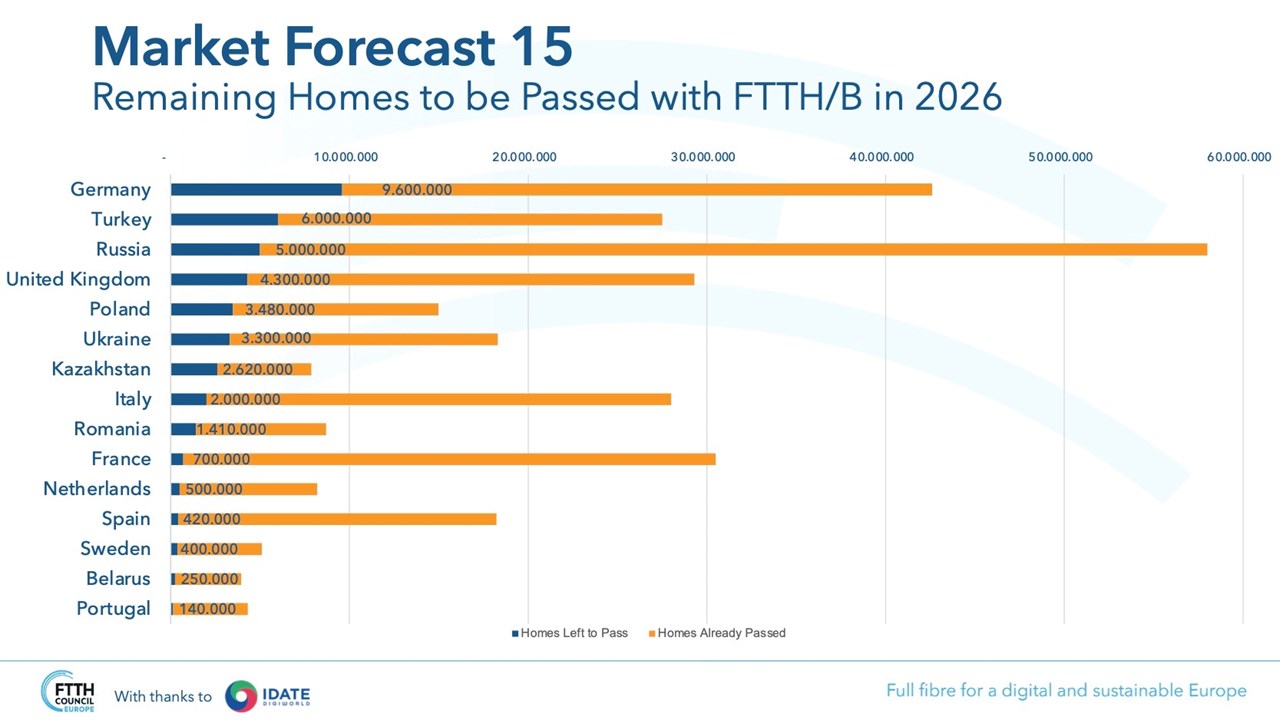FTTH Council Europe: 197 million homes passed in 2026 in EU27+UK
On September 15 the FTTH Council Europe released its updated Market Forecasts for 2021-2026. Those market forecasts cover 39 European countries [1.] and provide an individual analysis for 15 countries. The forecasts are consistent with previous estimates and plan for around 197 million homes passed for FTTH/B in 2026 in EU27+UK compared to 118 million this year, with Germany, the United Kingdom, the Netherlands and Italy to experience the most remarkable growth.
Note 1. The 39 countries included in IDATE’s research are: the 27 EU member states; four CIS nations – Belarus, Kazakhstan, Russia and Ukraine; Iceland, Israel, North Macedonia, Norway, Serbia, Switzerland, Turkey and the UK.
……………………………………………………………………………………………………………………………………………….

According to IDATE (which compiled the numbers) there will be 99 million households in the region (39 countries) with a fiber broadband connection at the end of this year, either directly via a fiber-to-the-home (FTTH) line or as part of a fiber-connected multi-dwelling building (FTTB), up from 81.9 million at the end of September 2020.
FTTH/B is progressively deployed, but at a very different pace amongst the countries under study. While Spain is championing the ranking with 60,5% rural FTTH/B coverage in 2020, Germany has still a long way to go with only 9,8% covered.
While more than two-third of rural households currently have an NGA2 access [2.]; FTTH/B coverage is still lagging behind in non-dense areas with only 22% households covered, compared to 45% for all territories in EU27+UK.
Note 2. NGA2 (Next Generation Access 2): NGA2 is a long-term solution with an entirely new optical network type. The objective of NGA2 is to provision an independent PON scheme, without being constrained by the GPON standards and the currently deployed outside plant.
………………………………………………………………………………………………………………………………………….
Several factors have played a role in fostering the deployment of networks. The Covid-19 crisis led to more data traffic and more demand, which has resulted in private investors boosting considerably their deployment projects in favor of FTTH/B to support the ongoing traffic increase. Adding to this, the launch of national programs (infrastructures and digitalization) and new European digital targets for 2025 and 2030 will lead to the acceleration of full-fiber connectivity across all European countries.
Whereas the general market forecasts report is publicly available, members of the FTTH Council Europe are granted exclusive access to the extended version of the asset, featuring very detailed data. This unique data allows regional and international network operators, manufacturers, and investors, to efficiently navigate their business & direct their investments where it’s most needed or will be viable in years to come.
Members of the FTTH Council Europe can access the full asset and other content & exclusive services via member-restricted extranet (subject to certain conditions).
References:
https://www.ftthcouncil.eu/knowledge-centre/all-publications-and-assets/248/ftth-b-in-rural-areas
FTTH Council Europe: FTTH/B reaches nearly 183 million (>50% of all homes)
http://www.fiber-optic-components.com/tag/fiber-optic-network
One thought on “FTTH Council Europe: 197 million homes passed in 2026 in EU27+UK”
Comments are closed.



Very interesting FTTH forecast from the FTTH Council Europe. The key unknown is how many of the homes passed will subscribe to fiber based high speed Internet?
Last December, the Council said that the number of FTTH/B subscribers in Europe is expected to more than double in the next six years, to 208 million in 2026 compared to an estimated 86 million this year. According to the forecasts by iDate presented at the annual FTTH Council Europe conference, the number of homes passed will grow over the same period to 317 million from 195 million. That means an around two-thirds penetration rate on the fiber networks, compared to less than half currently.
https://www.telecompaper.com/news/ftth-take-up-accelerating-in-europe-penetration-forecast-to-reach-65-in-2026–1364315